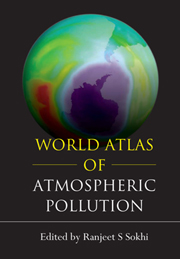Book contents
- Frontmatter
- Contents
- Contributors
- Foreword
- Preface
- Acknowledgements
- International Union of Air Pollution Prevention and Environmental Protection Associations (IUAPPA)
- Global Atmospheric Pollution (GAP) Forum
- Acronyms and Abbreviations
- Selected Units Used in Atmospheric Pollution Science
- INTRODUCTION
- CHAPTER 1 AIR POLLUTION HISTORY
- CHAPTER 2 AIR POLLUTION IN URBAN AREAS
- CHAPTER 3 LONG-RANGE TRANSPORT OF ATMOSPHERIC POLLUTANTS AND TRANSBOUNDARY POLLUTION
- CHAPTER 4 GLOBAL AIR POLLUTION AND CLIMATE CHANGE
- CHAPTER 5 OZONE DEPLETION
- CHAPTER 6 ENVIRONMENTAL AND HEALTH IMPACTS OF AIR POLLUTION
- CHAPTER 7 FUTURE TRENDS IN AIR POLLUTION
- References
- List of Useful Reading Material
- Index
INTRODUCTION
Published online by Cambridge University Press: 05 March 2012
- Frontmatter
- Contents
- Contributors
- Foreword
- Preface
- Acknowledgements
- International Union of Air Pollution Prevention and Environmental Protection Associations (IUAPPA)
- Global Atmospheric Pollution (GAP) Forum
- Acronyms and Abbreviations
- Selected Units Used in Atmospheric Pollution Science
- INTRODUCTION
- CHAPTER 1 AIR POLLUTION HISTORY
- CHAPTER 2 AIR POLLUTION IN URBAN AREAS
- CHAPTER 3 LONG-RANGE TRANSPORT OF ATMOSPHERIC POLLUTANTS AND TRANSBOUNDARY POLLUTION
- CHAPTER 4 GLOBAL AIR POLLUTION AND CLIMATE CHANGE
- CHAPTER 5 OZONE DEPLETION
- CHAPTER 6 ENVIRONMENTAL AND HEALTH IMPACTS OF AIR POLLUTION
- CHAPTER 7 FUTURE TRENDS IN AIR POLLUTION
- References
- List of Useful Reading Material
- Index
Summary
This introduction brings together the separate, but interlinked, themes of the chapters. Some of the key concepts of atmospheric pollution are explained to help those readers who are not familiar with the subject area but have a science background. This section also explains the overall structure of the Atlas and the approach adopted by the contributors. A list of useful reading material is provided at the end of the Atlas for those who are interested in an in-depth treatment of atmospheric science and pollution.
The Earth's Atmosphere
Radiation Balance of the Atmosphere
The overall atmospheric dynamics and the climate system are driven by the energy from the sun. Much of the incoming solar radiation is transmitted through the atmosphere and absorbed by the earth's surface (see Figure I.1). Some of this short-wave radiation is reflected by ground surfaces such as snow and deserts, and by clouds. About 30 per cent of the solar radiation incident on the earth is reflected back into space by clouds, the atmosphere and the earth's surface (Kiehl and Trenberth 1997). Approximately 20 per cent of the incident radiation is absorbed by the atmosphere, and the remaining proportion (about 50 per cent) warms the earth's surface (land and the oceans).
The proportion of incoming radiation that is reflected back by a surface depends on its reflectivity, and is termed ‘albedo’. For example, albedo of fresh snow is typically 0.8 and that of the earth and the atmosphere, 0.3.
- Type
- Chapter
- Information
- World Atlas of Atmospheric Pollution , pp. 1 - 6Publisher: Anthem PressPrint publication year: 2008



